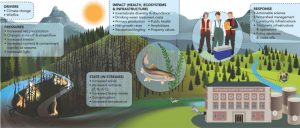In most parts of the World, the majority of water sources for drinking water supply originate from forest watersheds which are vulnerable to fire (Martin, 2016). It is estimated about 80% of the freshwater resources in the USA originate from forest land, and more than 3,400 public drinking water systems are found in national forest lands (USGS, 2018). Climate change has increased summer temperatures and high beetle infestations leading to generation of so much dry dead wood that acts as fuel for any fire (Gaylord, 2014). Globally, it is estimated about 300-400 million ha of landscape is burned by wildfire per year (Bladon et al. 2014). During period of 1960–2013, about 1.8 million ha per year was burned in USA while 2.1- and 0.8-million ha in Canada and Australia respectively (Bladon et al. 2014). Wildfire adversely impacts water supplies, water quality and also causes flooding downstream due to changes in stream discharge after heavy storms. Wildfires impacts are felt more by downstream water users since changes in water quality limit safe drinking water supply. Post-fire effects are connected to stream hydrology to higher peak flows, suspended sediment and bed load, as well as different chemical constituents from ash (Bladon et al., 2014).
However, the degree of water quality destruction depends on the precipitation characteristics which influence the amount of generated runoff. High storm intensity results to enormous post-fire impacts in the watershed including high sediment load and ash deposition into reservoirs and streams. There are also complications with snow melting dynamics for regulated water release to water sources when the forests canopy is burned (Martin, 2016). Timing of the snowmelt peak is very important in ensuring constant delivery of enough water to reservoirs especially during high water demand especially in summer (Martin, 2016). Additionally, mass wasting processes such as debris flows, stream bank failure and rock falls increase sediment transport downstream which eventually obstruct channels hence reduction in reservoir capacity (Emelko & Sham, 2014). Post-fire hydrologic and water quality changes cause increased operation costs of water providers for additional treatment processes, modification of treatment infrastructures and reservoir maintenance (Bladon et al. 2014). It is very costly to remove post-fire sediment from reservoirs in order to restore its capacity and minimizing chemical contamination of stored water (Emelko & Sham, 2014). It is reported that Denver, a city in Colorado State, USA, spent over $23 million USD to reclaim the main water supply reservoir (Martin, 2016). Relationship between wildfire impacts on clean water supply has to be fully understood by critically looking at the major causes, in order to suggest recommendations towards resiliency to wildfires (Emelko & Sham, 2014). There is still limited information about the extent, timing and duration of wildfire effects on water quality and this makes it difficult to evaluate the risks by drinking water providers and also be able to develop management options (USGS, 2012). Therefore, collaborative efforts between the forest management services and watershed managers as well as drinking water utilities should be prioritized in order to develop solutions to curb wildfires effects.

Figure 2: Wildfire causes and changes in water quality and impacts on aquatic life and drinking water supply with possible mitigation strategies (Source: Bladon et al., 2014)
